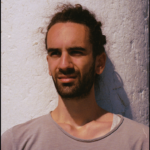A look into a Berlin corner
 The building is located in the city of Berlin, very close to the train station of Gesundbrunnen in Wedding. It overlooks a quiet street on one side and the S-Bahn railways on the other side. The architect Arno Brandlhuber and Muck Petzet built this commercial and residential five-story building, named Terrassenhaus, between 2014 and 2018. The name Terrassenhaus would be translated into English as „Terrace House“.
The building is located in the city of Berlin, very close to the train station of Gesundbrunnen in Wedding. It overlooks a quiet street on one side and the S-Bahn railways on the other side. The architect Arno Brandlhuber and Muck Petzet built this commercial and residential five-story building, named Terrassenhaus, between 2014 and 2018. The name Terrassenhaus would be translated into English as „Terrace House“.
A friend of the editorial board Nathalia Kharkova and I visited the site and collected observations.
When we first walked down the street and saw the building, we noticed that it paticularly stands out because of its geometrical shape: the monotone gray facade is not aligned with the other ones. The floors increasingly recede from the frontfacades of the street, leaving room for a square below, to be used by pedestrians as well. The house is attached only on its left side to the neighbouring house and it is independent on the right side.
The raw concrete structure is extremely clear and the glass windows on every floor allow people to look through the building. There is almost no opaque surface that blocks your curious eye from seeing what is going on inside and in the courtyard behind.
As we further walked down the street, we saw that the other side of the house, which is sitting in a trapezoidal piece of land, has an opposite character. This front is totally blind: a rough concrete wall folded like paper and a very thin staircase on top are the only visible things. In such a way the building is only open towards the north-south axis and locked on the east-west axis. What at first seemed to be an amorphous composition turns out to be more similar to an irregular mineral.
The shape of the building cannot still be fully understood before having a look at the backside. From this inner courtyard the system of the whole project becomes clear: every floor has a single horizontal glass facade and a wide six-meter-deep non-overlapping terrace, which is shared by the two apartments on every floor.
Furthermore from south to north a staircase runs on both sides of the perimeter of the building. In such a way all the terraces are accessible from the east as well as from the west side and everyone is free to step on every corner of the property. In such a manner the private and and the public spaces are connected to a point where they are no longer distinguishable.
After having briefly described the overall shape, I would like to point out a couple of objective-subjective observations starting from the backside.
When we now focus on these terraces and their proportions and how they were „sculpted“, some elements stand out over others. These volumes and its surfaces confluence into particular directions which may suggest a certain quality of movement.
We notice that the concrete slabs and the metal handrails are strong elements that create a firm and tight horizontal, rythmic succession. This „tempo“, increased by the incident perspective lines that the staircases on both sides of the building convey (the building has trapezoidal plan), favours an accelerated and troubled look over the terraces. This movement the eye is driven to stops suddenly reaching the common roof top and then the sky. This interrupted climax is caused by the lack of a clear end or, as I like to call it „head of the building“. The shape suggests actually that the structure or pattern slab-handrail could be reproduced endlessly. The project suggests a process suddenly stopped.
The only element that tries to unify the ensemble is the staircase which encloses the perimeter. Such circular, boundary-less circulation brings a fundamental sence of playfullness and lightness to the project, even if in a fragile and bare way. That manages to elevate the mass of the whole built body.
The dynamic just mentioned, rules indeed the whole north-south axis and can be experienced also from the outside.
On this axis the profile given on one side by the retractive facade and the ziggurat like on the other side marks a clear diagonal. It seems if the entire building could stretch and reach out over the street. However, as noticed before, the direction the eye instinctively follows is leading into nowhere. The whole ensemble looks like the base of a bridge which has not been built to an end, and could actually still grow and extend, suggesting a sence of firminess that it is not yet to be fulfilled.
The quality of the architecture that generally preveys is the overall layout strongly determining the life of the residents and challenging our current living manner. Though the project recreates a small ecosystem that embodies a global world without boundaries, provides a generous space, where meeting people and exercising a communal life is possible which is a crucial part for our individual well-being and development.
Nevertheless the few aspects mentioned in the text also affect the outcome of the project, even if they are less tangible, but still have a strong impact on the human being.
The architecture expresses a severe, cool and gloomy language which, on our way home, reminded me of the colour „The Cursed Poets“ used in their poems.







